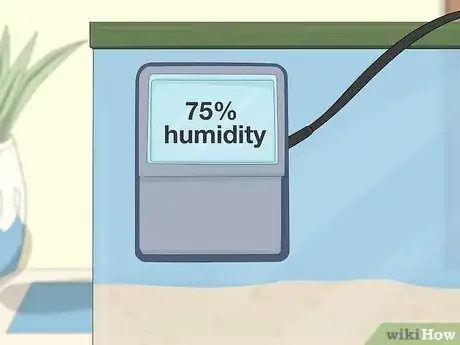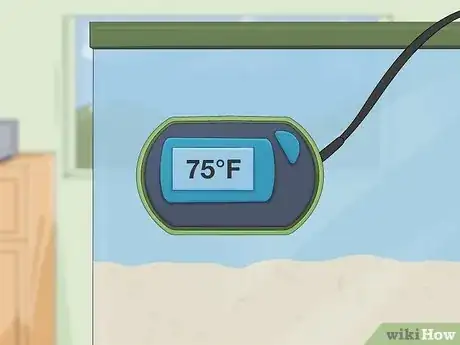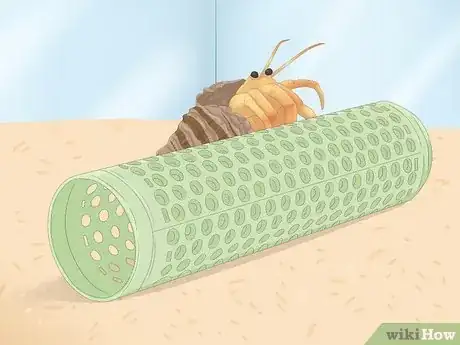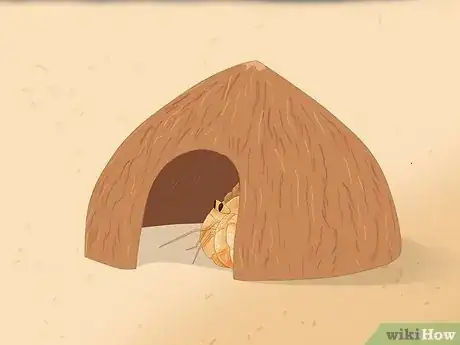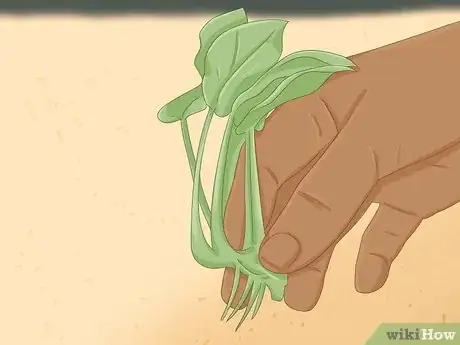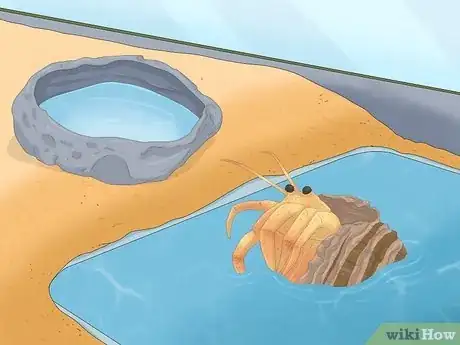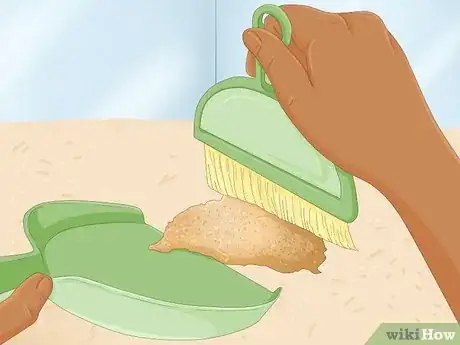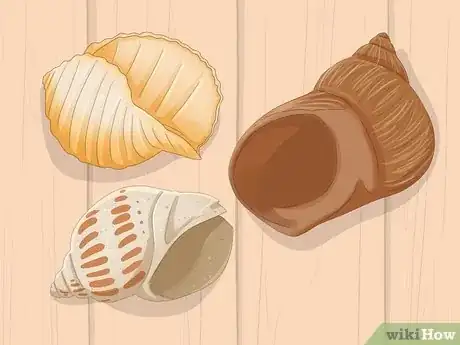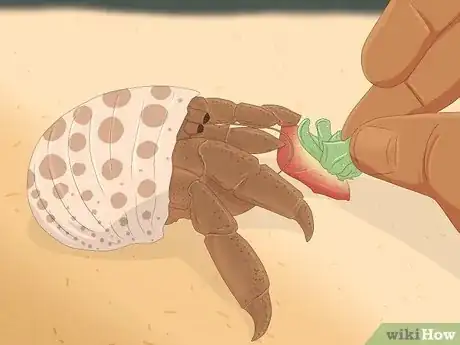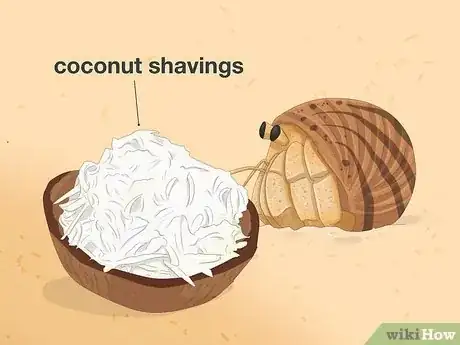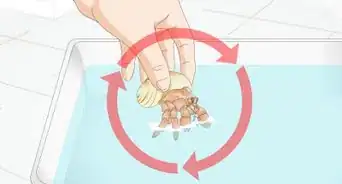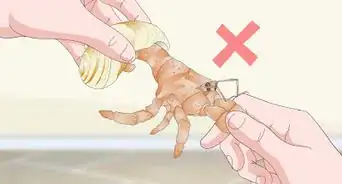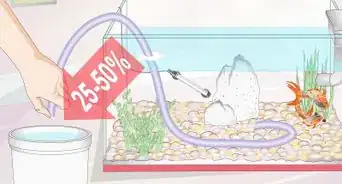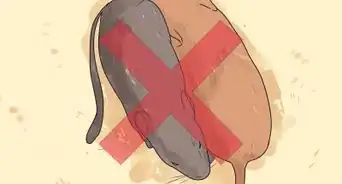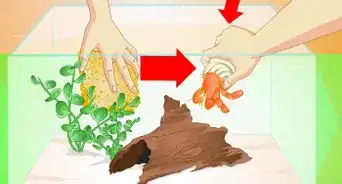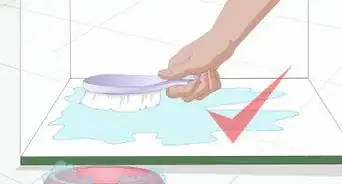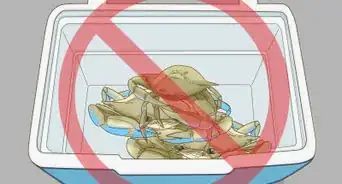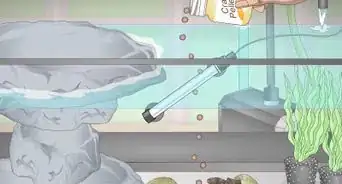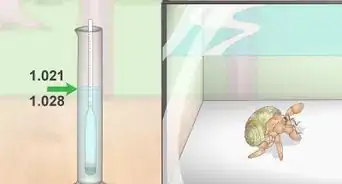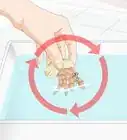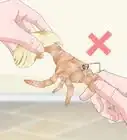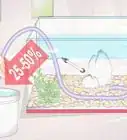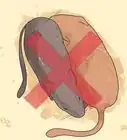This article was co-authored by Marshall Stephens. Marshall Stephens is an Aquarium Expert at Private Oceans Aquariums in West Palm Beach, Florida. Marshall has over 20 years of experience in the aquarium industry and focuses on captive-bred animals. They specialize in tropical and marine aquariums and are a contributor to the Loggerhead Marine life center in Jupiter Florida.
There are 19 references cited in this article, which can be found at the bottom of the page.
wikiHow marks an article as reader-approved once it receives enough positive feedback. This article received 140 testimonials and 100% of readers who voted found it helpful, earning it our reader-approved status.
This article has been viewed 1,991,661 times.
Hermit crabs, affectionately called hermies, are phenomenal low maintenance pets. But low maintenance doesn’t mean no maintenance! These cute little crabs need an adequate habitat and plenty of supplies, and we’re here to cover everything you need to know to keep these critters happy and healthy. Read on to learn how to care for hermit crabs.
Things You Should Know
- Hermit crabs can live up to 10 years and grow to be over 6 in (15 cm) in size, so don’t buy a hermit crab in a tiny tank on a whim.
- Hermit crabs are social and thrive in environments where they have at least one other crab to live with, although more is always better.
- Keep the humidity at least 75% and the temperature 75–85 °F (24–29 °C) at all times to ensure your crabs stay healthy.
- Fill your crab’s habitat with children’s playsand, cocofiber, moss, empty shells, freshwater, saltwater, and climbing toys.
Steps
Setting Up a Healthy Habitat
-
1Get a tank that’s 10 US gal (38 L) for every 2 crabs. So, if you have 6 hermit crabs, they’ll need at least 30 US gal (110 L) of space. A proper home for your crabs should hold humidity but still let in fresh air, so a fish tank or reptile aquarium usually does nicely. You can even rinse out that old leaking tank from the attic and use it! Acrylic terrariums tend to work too.
- If the hermit crabs are on the larger size, opt for a bigger tank than necessary.
- Hermit crabs like having plenty of space, so bigger is always better with the habitat.
- You can theoretically even keep your crabs in a big plastic bin, if you’re really short on materials.
-
2Maintain a humidity of roughly 75% at all times. Get a a hygrometer (humidity gauge) and stick it in the crabs’ habitat to track the humidity. Whenever it gets too low, mist their cage with a little water. Hermit crabs breathe through (hardened) gills, and can't breathe properly unless the air is humid enough, so keep them moist at all times.[1]
- A great way to increase your tank's humidity naturally is to add natural moss to your tank.[2] It increases the humidity, and hermit crabs love to snack on it it.
- Damp crab sponges are also a great way to keep the humidity high in a hermit crab tank.
Advertisement -
3Keep the temperature roughly 75–85 °F (24–29 °C) at all times. Hermit crabs are tropical animals who prefer in warm temperatures. Heat damage is irreversible, and temperatures that are too low can slow down a crab's metabolism, so maintaining a stable temperature is essential. An under-tank heater designed for hermit crabs is ideal, but you can also just set the tank in a part of your home that stays perpetually warm, too.
- Attach a tank thermometer to your crabs’ home to monitor the temps.
-
4Fill the habitat with a substrate of kid’s playsand or cocofiber. Hermit crabs are diggers, and they’ll spend a lot of time under or in the substrate you choose. As such, pick something fine and safe. Your two best options are the playsand designed for small children, coconut fiber, or a mix of the two. Cover the bottom of your tank with substrate.[3]
- Many crabs also like to bury and even molt in damp reptile moss.
- Aim to keep the substrate depth 3 times the height of your biggest crab. So, if you estimate your biggest crab is 3 inches (7.6 cm) tall, keep the substrate 9 inches (23 cm) deep.
-
5Set some climbing toys out for your hermit crabs. You may be surprised to learn that hermies love to climb! In the wild, they will climb large rocks exposed by low tide to search for food. Hermit crabs are sometimes called “tree crabs” because they’ll even climb trees to eat insects and vegetation. Just stay away from painted toys, since they can be toxic to hermit crabs.[4]
- Natural rocks and seashells that you pick up at the beach are great to scatter around the crabitat. Clam shells even make great food dishes! Just make sure to boil them in boiling water so that they become sterilized before you place them in the tank.
- Plastic plants made for reptiles are great for crabs to climb and hide in. Just remember to use the lid of your tank so the crabs can't climb out.
- Never use reptile “half pine logs,” as pine is an irritant to the crabs and can be toxic.[5]
-
6Provide your hermit crabs with plenty of hiding places. Hermit crabs, like most animals, need a place to feel secure and hide when they feel threatened. You can use a half coconut shell that they sell at pet stores for small crabs, or use broken pots, large shells, etc. Just make sure that the crab won't get stuck inside.
-
7Add some live plants to your tank if you’d like. Live plants can be a great addition to any tank. In particular, plants like bamboo (make sure it's real bamboo and not Dracaena Sanderiana, which is sold as “lucky bamboo”), Venus fly traps bromeliads (air plants), pothos, and spider plants are among the other safe plants. Be forewarned--your hermit crabs may snack on them, so there's no guarantee the plants will have time to grow.[6]
- You do not need to include live plants if you don’t want to; your hermit crabs will be just fine without them. They do provide some fun snacks for the crabs and add some beautiful decoration, though!
-
8Provide your hermies with clean fresh and salt water at all times. Provide at least two water dishes (one freshwater and one saltwater) for your crabs. Hermit crabs need to balance the salinity of the water in their shells; the dishes should be at least deep enough that your crab can get water in its shell. A good way to do this is to provide them with a sloping water area, where one part is shallow and easy to climb out of, while the other is deep and they can submerge themselves in the water.[7]
- For your saltwater, use salt designed for marine fish. Never use salt intended for human consumption because the anti-caking agents can be harmful.
- Always use dechlorinated water. The chlorine, chloramines, and heavy metals in most tap water can kill hermit crabs by causing the gills to blister (causing eventual suffocation).
Caring for Your Crabs
-
1Replace the substrate every 6 months or so. Dirty substrate can lead to mold which can be harmful to your hermit crabs. Change it every 6 months or whenever their habitat starts to smell a little questionable. If you see mold or you spot a mite infestation, change the substrate ASAP. In between substrate cycles, spot clean any dung and food the crabs have dragged from the food bowl or buried.[8]
- Never clean the substrate when your hermit crab is molting. You should never disturb or move a molting crab.
-
2Handle your hermies with extreme care and patience. Hermit crabs normally get kind of twitchy when you touch them, so go slow. When you get your hermit crabs, leave them in the cage for a few days. When you see that they don't hunch into their shell when you pass by then wait another day and try to hold your hermit crab. Let your hermit crab explore your hand and get used to you.[9]
- Once you get them home, they go through a “de-stressing” period that can take as little as a few days and as long as two months. During this time, change out their food and water regularly and do not disturb them.
- Your crabs probably won’t like being held, but many hermit crabs will learn to tolerate handling if you go slow and you don’t make a lot of sudden movements.
-
3Let your hermit crabs molt in undisturbed peace. If a crab digs under the substrate for a couple of weeks, don't worry. It’s molting! Do not disturb your crab during this time. They need to be alone and if they are bothered, the stress could kill them. A crab's exoskeleton gets tight as they grow, and molting is how they solve this problem. They shed their exoskeleton and grow a new one, so let them be.[10]
- Don't take the exoskeleton away from the crab! They will need to eat it in order to harden their new exoskeleton when they’re done.
- If your crab behaves like they’re sick, don't panic. Keep an isolation tank in a closet with enough substrate to dig under completely and ample food and water. Crabs often act sick when they’re about to molt, so the odds are good they’re fine.
-
4Set out multiple extra shells to give your crabs options. When hermit crabs grow, they look for bigger shells. Keep plenty of extra hermit crab shells similar to your crabs' sizes in the tank at all times; they’ll go around and look for new housing as they see fit. Once a month or so, rotate a few undisturbed shells out with different styles of shells.
- Purple Pincher Hermit Crabs prefer the shells with round, circular openings. They will choose circular openings over the oval openings. Ecuadorian Hermit Crabs will prefer an oval opening, because they have flatter abdomens.
- Never buy painted shells! Although companies may claim the paint is safe, the paint can chip off, and if the crabs eat it, it can be toxic.[11]
-
5Feed your crabs a varied and healthy diet of hermit crab food. Hermit crabs are scavengers by nature and will eat almost anything. Provide a base diet of commercial hermit crab food. Any high-quality product will work so long as it’s designed for hermit crabs.
- Hermit crabs love fresh shrimp, freeze-dried krill, blood worms, and other seafood. You can normally buy these fishy foods at your local grocery store.
- If you cook, set aside a piece of steak or chicken, non-marinated to grill lightly for the crabs. They enjoy raw meat!
- If you have more than 20 crabs or so, get a fish head from a local fish market as an occasional treat.
-
6Offer fruits and veggies to your hermit crabs to keep them healthy. Aside from eating meat, hermit crabs also love different fruits and vegetables. Remember to change their food almost every day or night. Hermit crabs love to bury their uneaten food, and this can cause molding and is messy.[12]
- Hermit crabs love fresh fruit like pineapple, apple, pears, grapes, cantaloupe, watermelon, mango, papaya, strawberries, bananas, etc. Wash your fruit thoroughly before you cut it, to avoid pesticides.
- Crabs will go crazy for coconut shavings!
- Hermit crabs will also eat natural peanut butter on whole wheat toast, hard boiled eggs, egg shells (boiled), and popcorn (plain, unsalted and unbuttered).
- Avoid anything from the Allium species of plants (onion, garlic, etc.).
-
7Be aware that hermit crabs may pinch. While they generally pinch only when they are afraid or feel cornered, they may pinch for no reason, so don’t take it personally if your hermie gets a little snappy from time to time. If they pinch, just gently turn your hand over in the tank and let gravity gently drop the crab off of your hand.[13]
Expert Q&A
Did you know you can get premium answers for this article?
Unlock premium answers by supporting wikiHow
-
QuestionHow can you keep hermit crabs you find at the beach?
 Marshall StephensMarshall Stephens is an Aquarium Expert at Private Oceans Aquariums in West Palm Beach, Florida. Marshall has over 20 years of experience in the aquarium industry and focuses on captive-bred animals. They specialize in tropical and marine aquariums and are a contributor to the Loggerhead Marine life center in Jupiter Florida.
Marshall StephensMarshall Stephens is an Aquarium Expert at Private Oceans Aquariums in West Palm Beach, Florida. Marshall has over 20 years of experience in the aquarium industry and focuses on captive-bred animals. They specialize in tropical and marine aquariums and are a contributor to the Loggerhead Marine life center in Jupiter Florida.
Aquarium Specialist If it's a land-based hermit crab, you can care for it in a 10-gallon tank with a sand base, some hiding spots, some places to crawl around in, and a sponge soaked in water. To feed it, use pellets that are made specifically for hermit crabs. If it's a water-based crab, you can put it in your aquarium as a scavenger to hep keep the tank free of food that would otherwise sit around and cause water quality issues.
If it's a land-based hermit crab, you can care for it in a 10-gallon tank with a sand base, some hiding spots, some places to crawl around in, and a sponge soaked in water. To feed it, use pellets that are made specifically for hermit crabs. If it's a water-based crab, you can put it in your aquarium as a scavenger to hep keep the tank free of food that would otherwise sit around and cause water quality issues. -
QuestionAre hermit crabs easy to take care of?
 wikiHow Staff EditorThis answer was written by one of our trained team of researchers who validated it for accuracy and comprehensiveness.
wikiHow Staff EditorThis answer was written by one of our trained team of researchers who validated it for accuracy and comprehensiveness.
Staff Answer wikiHow Staff EditorStaff AnswerIt depends on what you mean by "easy." They can’t be placed into any old container and left alone with little interaction or enrichment. They need careful and considerate setup of a large tank space and their environment needs checking daily to ensure that everything is okay, such as the temperature, removal of foul food, cleaning dirty objects, etc., as crabs are susceptible to parasites and mold. You also need to provide a balance of proper nutritious food as well. Provided you are happy to do all these things regularly and properly, your crab can be "easy" to take care of. Importantly, failing to provide optimal living conditions will be to the detriment of the crab’s health, don’t do your research and be prepared for daily care routines that ensure the crab’s health, happiness and longevity.
wikiHow Staff EditorStaff AnswerIt depends on what you mean by "easy." They can’t be placed into any old container and left alone with little interaction or enrichment. They need careful and considerate setup of a large tank space and their environment needs checking daily to ensure that everything is okay, such as the temperature, removal of foul food, cleaning dirty objects, etc., as crabs are susceptible to parasites and mold. You also need to provide a balance of proper nutritious food as well. Provided you are happy to do all these things regularly and properly, your crab can be "easy" to take care of. Importantly, failing to provide optimal living conditions will be to the detriment of the crab’s health, don’t do your research and be prepared for daily care routines that ensure the crab’s health, happiness and longevity. -
QuestionDo hermit crabs make good pets?
 wikiHow Staff EditorThis answer was written by one of our trained team of researchers who validated it for accuracy and comprehensiveness.
wikiHow Staff EditorThis answer was written by one of our trained team of researchers who validated it for accuracy and comprehensiveness.
Staff Answer wikiHow Staff EditorStaff AnswerHermit crabs need a lot of care and effort to ensure they thrive, which can make them a high maintenance pet. For instance, they must be kept in an environment that is cleaned often and has high humidity, they must be fed proper nutritious food and they must be given plenty of space to live their lives. One problem is that hermit crabs don’t live as long in captivity as they would in the wild––many don’t survive beyond the first year whereas in the wild, a hermit crab has the chance to live for up to 30 years. And while they are endearing and entertaining creatures, they are meant to live in colonies and are highly sociable, so keeping one or even two can prevent them from living the bigger social life nature their species is used to. Do your research before deciding this is the right animal for you to keep in captivity.
wikiHow Staff EditorStaff AnswerHermit crabs need a lot of care and effort to ensure they thrive, which can make them a high maintenance pet. For instance, they must be kept in an environment that is cleaned often and has high humidity, they must be fed proper nutritious food and they must be given plenty of space to live their lives. One problem is that hermit crabs don’t live as long in captivity as they would in the wild––many don’t survive beyond the first year whereas in the wild, a hermit crab has the chance to live for up to 30 years. And while they are endearing and entertaining creatures, they are meant to live in colonies and are highly sociable, so keeping one or even two can prevent them from living the bigger social life nature their species is used to. Do your research before deciding this is the right animal for you to keep in captivity.
Things You'll Need
- Habitat with lid
- 2 water dishes
- Hiding spots for tank
- Extra shells
- Substrate
- Climbing toys
- Thermometer
- Hygrometer
- Tank heater
References
- ↑ https://www.hermitcrabassociation.com/pages/BasicHermitCrabCare.pdf
- ↑ http://crabstreetjournal.org/blog/2012/10/16/faq-how-do-i-create-and-maintain-humidity-in-my-crabitat/
- ↑ https://www.hermitcrabassociation.com/pages/BasicHermitCrabCare.pdf
- ↑ https://www.arl-iowa.org/webres/File/Hermit%20Crab%20Care.pdf
- ↑ http://crabstreetjournal.org/blog/2014/02/18/safe-and-unsafe-wood/
- ↑ http://crabstreetjournal.org/blog/2016/03/23/setting-proper-crabitat/
- ↑ https://www.hermitcrabassociation.com/pages/BasicHermitCrabCare.pdf
- ↑ https://aquaticsolutions.com.au/blogs/care-sheets/hermit-crab-care-sheet
- ↑ https://www.hermitcrabanswers.com/do-hermit-crabs-like-to-be-handled/
- ↑ https://nationalzoo.si.edu/animals/land-hermit-crab
- ↑ http://crabstreetjournal.org/blog/2015/04/19/say-no-to-painted-shells/
- ↑ https://www.petsintheclassroom.org/wp-content/uploads/2017/08/PIC-care-sheet-Hermit-Crab-1.pdf
- ↑ https://hermit-crabs.com/aggression.html
- ↑ https://www.hermitcrabanswers.com/how-do-hermit-crabs-breed-in-captivity/
About This Article
To properly care for hermit crabs, place them in a large tank with a layer of substrate they can bury themselves in. Hermit crabs are social, so you should have at least 3-4 animals in each tank. Keep the humidity in the tank at 75-85% and the temperature between 75° and 85°F. You should provide your crabs with extra shells, climbing toys, and places to hide. Place one dish with freshwater and one dish with saltwater in the tank, and feed your hermit crabs a varied diet of seafood, fruit, veggies, and meat. For tips on keeping the substrate clean, read on!

